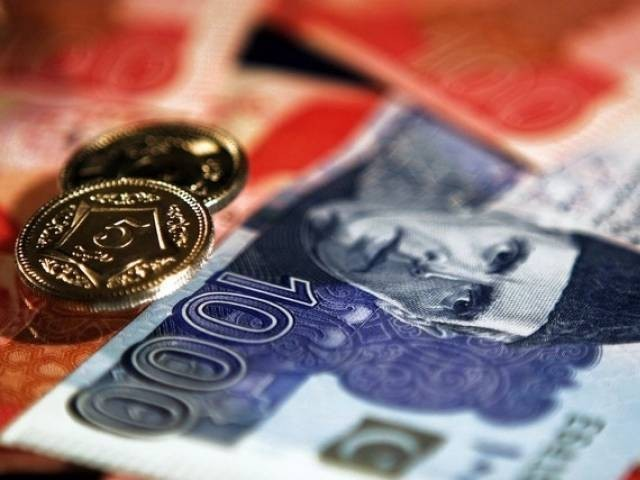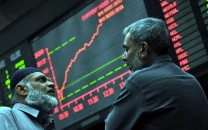Govt debt rises only 4% to Rs33tr by end-January
Debt growth slows due to stable exchange rate, better non-tax revenues

PHOTO: FILE
The debt bulletin that the State Bank of Pakistan (SBP) released on Tuesday showed that the central government’s debt stood at Rs33 trillion by the end of January 2020. In January last year, the central government’s debt was Rs31.8 trillion, excluding debt and liabilities of the central bank and public sector enterprises.
However, on a year-on-year basis, the central government’s debt grew 22% or Rs5.9 trillion due to massive devaluation in the second half of last fiscal year and a steep shortfall in tax revenues. In the current fiscal year, the rupee largely remained stable against the greenback, except for the past two days when it shed over 2.1% of its value.
The rupee was traded at Rs157.5 to a dollar on Tuesday in the inter-bank market. If the trend continued in coming days, this may again adversely affect the central government’s debt position that is highly sensitive to the exchange rate volatility. When Imran Khan became the prime minister, the central government’s debt was close to Rs24.5 trillion and under his watch about Rs8.5 trillion has been added, excluding liabilities.
Pakistan's external debt, liabilities rise $600m
In February last year, PM Imran vowed to bring the public debt below Rs20 trillion.
The general government debt, including guarantees and borrowing from the International Monetary Fund (IMF), rose to 88% of the gross domestic product (GDP) by the end of previous fiscal year, according to the IMF. In the current fiscal year too, the IMF has revised upwards its projection for public debt and liabilities to 84.7% of GDP or Rs37.6 trillion, showed a report.
The central government debt comprises long and short-term domestic debt and external debt.
The central bank is also under increasing pressure to cut the policy rate, which is currently 4.75 percentage points higher than the core inflation. The SBP’s Monetary Policy Committee (MPC) will hold a meeting next week to review the policy.
The Ministry of Finance has twice postponed a scheduled meeting of the Monetary and Fiscal Policies Coordination Board, which it called ahead of the MPC huddle to give a direction for the monetary decision-making.
The 13.25% policy rate has significantly increased the cost of debt servicing, which is now projected at Rs3.2 trillion for the current fiscal year or 60% of the Federal Board of Revenue’s (FBR) revised revenue collection target.
FBR’s revenues are not growing at a pace desired by the IMF. But non-tax revenues have significantly increased in the first half of current fiscal year due to a profit of Rs426 billion registered by the central bank and one-off payments by the telecom operators. Other taxes have also increased on the back of a higher petroleum levy.
The SBP report showed that the central government’s total domestic debt increased from Rs20.7 trillion in June last year to Rs21.8 trillion in January, a net addition of Rs1.1 trillion or 5.2%. The report showed that a major increase in the federal government’s debt was on account of long-term debt, which swelled from Rs15.2 trillion to Rs16.7 trillion. There was an increase of Rs1.5 trillion or 10% in the long term debt.
This was because of the government’s decision to convert its short-term borrowing from the central bank to long-term debt.
The short-term domestic debt dropped from Rs5.5 trillion in June 2019 to Rs5.1 trillion in January this year due to the shift of borrowing to long-term instruments. There was a reduction of Rs454 billion or 8.2% in the short-term debt.
Debt, liabilities mount to Rs40.2 trillion
The federal government’s debt, acquired through the sale of Market Treasury Bills (MTBs) to commercial banks, decreased from Rs4.9 trillion to Rs4.7 trillion, a reduction of Rs169 billion or 3.4% in seven months. The external debt of the central government increased from Rs11 trillion in June to Rs11.2 trillion in January, an addition of Rs147 billion or 1.4%. The external debt of the central government did not increase at a rapid pace due to the booking of IMF liabilities and hot foreign money on books of the central bank.
The hot foreign money has also started gradually flowing out as foreign investors pulled out $552.5 million, mainly the UK investors. But there were still sizeable hot money inflows, standing at $3.4 billion. The term is used for foreign investment in the government’s debt securities. It is called hot because the money flows towards the destination where the rate of return is high, like currently in Pakistan where investors are paid 13.3% interest on investment.
Published in The Express Tribune, March 11th, 2020.
Like Business on Facebook, follow @TribuneBiz on Twitter to stay informed and join in the conversation.



















COMMENTS
Comments are moderated and generally will be posted if they are on-topic and not abusive.
For more information, please see our Comments FAQ